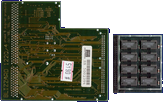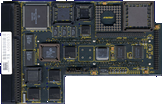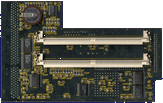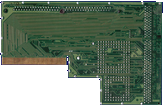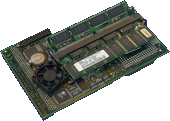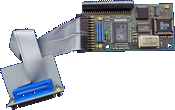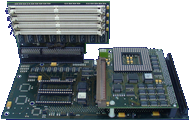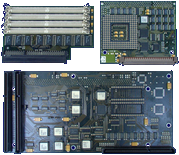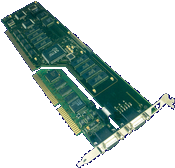Manufacturer “Phase 5 Digital Products”
27 expansions in database
Manufacturer Phase 5 Digital Products, Germany | Date 1993 | Amiga A1200 | Interface trapdoor slot | Autoconfig ID 8512 / 6 |
- 4 MB 80 ns RAM on board (eight DIP chips)
- expandable to 8 MB with the Add-4 Board via the 62 pin expansion port
- optional PLCC FPU, 68881 / 68882 @ 14, 20 - 40 MHz
- without an oscillator the FPU can run only at 14 MHz
- with a suitable oscillator installed, it can run between 20 and 40 MHz
- battery backed up clock - it was optional on earlier revisions
Manufacturer Phase 5 Digital Products, Germany | Date 1994 | Amiga A1200 | Interface trapdoor slot | Autoconfig ID 8512 / 6,12 |
- processor
- 68EC020 @ 28 MHz QFP
- optional PLCC FPU, 68881 @ 14 MHz - 68882 @ 40 MHz
- memory
- 4 MB 70 ns RAM on board (eight DIP chips)
- expandable to 8 MB with special Add-4 Board
- notes
- disable switch
- battery backed up clock
Manufacturer Phase 5 Digital Products, Germany | Date 1993 | Amiga A1200 | Interface trapdoor slot | Autoconfig ID 8512 / 11,13 |
- processor
- 68EC030 @ 40 MHz, QFP
- optional FPU, PLCC and PGA sockets - can be clocked synchronously or asynchronously with the 68030 up to 50 MHz
- memory
- two 72 pin SIMM sockets accept 64 MB RAM
- supports 1, 2, 4, 8, 16, 32 MB SIMMs
- hardware maprom - no need for MMU
- notes
- optional Fast SCSI 2 controller (FAS216) with DB25 external connector, supported by NetBSD and OpenBSD
- battery backed up clock
Manufacturer Phase 5 Digital Products, Germany | Date 1994 | Amiga A1200 | Interface trapdoor slot | Autoconfig ID 8512 / 11,13 |
- processor
- 68EC030 @ 40 MHz or 68030 @ 50 MHz PGA
- optional FPU, PLCC and PGA sockets - can be clocked synchronously or asynchronously with the 68030 up to 50 MHz
- memory
- two 72 pin SIMM sockets accept 64 MB RAM
- supports 1, 2, 4, 8, 16, 32 MB SIMMs
- hardware maprom - no need for MMU
- notes
- optional Fast SCSI 2 controller (FAS216) with DB25 external connector, supported by NetBSD and OpenBSD
- battery backed up clock
Manufacturer Phase 5 Digital Products, Germany | Date 1995 | Amiga A1200 | Interface trapdoor slot | Autoconfig ID 8512 / 11,13 |
- processor
- 68EC030 @ 40 MHz or 68030 @ 50 MHz PGA
- optional 68882 @ 25 / 33 / 50 MHz PGA
- memory
- one 72 pin SIMM socket accepts 32 MB RAM
- hardware maprom
Manufacturer Phase 5 Digital Products, Germany | Date 1995 | Amiga A1200 | Interface trapdoor slot | Autoconfig ID 8512 / 17 |
- processor
- 68030 @ 50 MHz PGA
- optional 68882 @ 50 MHz PGA
- memory
- one 72 pin SIMM socket accepts up to 128 MB, 60-70 ns RAM
- maprom selectable by jumper
- automatic RAM size detection
- optional Fast SCSI 2 DMA controller (
- 7 MB/s asynchronous, 10 MB/s synchronous transfer speed
- additional 72 pin SIMM socket accepts up to 128 MB RAM
- external DB25 female SCSI connector
- supported by Linux, NetBSD and OpenBSD
- notes
- can be disabled with a simple keystroke
- battery backed up clock
- BlizzardSCSI4-de.pdf
SCSI Kit user manual (german)
129 kB - BlizzardSCSI4.pdf
SCSI Kit user manual (english)
128 kB
- P5-SCSI-Tools-13.dms
SCSI tool disk v1.3
(for driver versions before v7.x)
425 kB - P5-SCSI-Tools-20.lha
SCSI tool disk v2.0
222 kB - P5-SCSI-Tools-21.dms
SCSI tool disk v2.1
287 kB - P5-SCSI-Tools-22.dms
SCSI tool disk v2.2
520 kB - P5-SCSI-Tools-24.dms
SCSI tool disk v2.4
520 kB
Manufacturer Phase 5 Digital Products, Germany | Date 1995 | Amiga A1200 | Interface trapdoor slot | Autoconfig ID 8512 / 17 |
- processor
- 68040 @ 40 MHz / 68060 @ 50 MHz
- the 68040s are recycled from used Macs
- memory
- one 72 pin SIMM socket accepts up to 64 MB RAM, 70 ns or faster
- only single sided SIMMs fit
- automatic SIMM size detection
- maprom selectable by jumper
- optional Fast SCSI 2 DMA controller (
- 7 MB/s asynchronous, 10 MB/s synchronous transfer speed
- additional 72 pin SIMM socket accepts 128 MB RAM
- external DB25 female SCSI connector
- supported by Linux, NetBSD and OpenBSD
- notes
- can be disabled with a simple keystroke, including SCSI and RAM
- battery backed up clock
- incompatible with the Squirrel SCSI interface and with the Mikronik towers
- Blizzard1240-de.pdf
user manual (DCE, german)
89 kB - Blizzard1240.pdf
user manual (DCE, english)
92 kB - BlizzardSCSI4-de.pdf
SCSI Kit user manual (DCE, german)
129 kB - BlizzardSCSI4.pdf
SCSI Kit user manual (DCE, english)
128 kB
- P5-SCSI-Tools-13.dms
SCSI tool disk v1.3
(for driver versions before v7.x)
425 kB - P5-SCSI-Tools-20.lha
SCSI tool disk v2.0
222 kB - P5-SCSI-Tools-21.dms
SCSI tool disk v2.1
287 kB - P5-SCSI-Tools-22.dms
SCSI tool disk v2.2
520 kB - P5-SCSI-Tools-24.dms
SCSI tool disk v2.4
520 kB - P5-SystemDisk-421.dms
install disk v2.0
68060.library v42.1 (14.10.1997), ppc.library v44.29Beta
297 kB - P5-SystemDisk-431.dms
install disk v2.0
68060.library v43.1 (05.02.1998), ppc.library 45.17Beta
353 kB - blizzard1260.DMS
Installer's Heaven
install disk
582 kB
Manufacturer Phase 5 Digital Products, Germany | Date 1996 | Amiga A2000 | Interface CPU slot | Autoconfig ID 8512 / 24 |
- processor
- 68040 @ 40 MHz / 68060 @ 50 MHz
- the 68040s are recycled from used Macs
- memory
- four 72 pin SIMM sockets accept 128 MB RAM
- supports 4, 8, 16, 32 MB SIMMs, 70 ns or faster
- fully autoconfiguring
- maprom selectable by jumper
- Fast SCSI 2 DMA controller
- 7 MB/s asynchronous, 10 MB/s synchronous transfer speed
- 50 pin internal header
- 50 pin external connector
- supported by Linux, NetBSD and OpenBSD
- notes
- 68000 fallback mode selectable with a simple keystroke at startup - works only with rev. B A2000s
- Blizzard 2040 ERC boards with SN# A400001 - A400094 were delivered with a defective DiagROM
- the 68040 processor is recognized as 68LC040 or 68EC040
- boards with these serial numbers had to be sent back to Phase5 to obtain a new DiagROM set including a new SCSI driver
- Blizzard2060-de.pdf
user manual (DCE, german)
158 kB - Blizzard2060.pdf
DCE
user manual (DCE, english)
160 kB
- P5-SCSI-Tools-13.dms
SCSI tool disk v1.3
(for driver versions before v7.x)
425 kB - P5-SCSI-Tools-20.lha
SCSI tool disk v2.0
222 kB - P5-SCSI-Tools-21.dms
SCSI tool disk v2.1
287 kB - P5-SCSI-Tools-22.dms
SCSI tool disk v2.2
520 kB - P5-SCSI-Tools-24.dms
SCSI tool disk v2.4
520 kB - P5-SystemDisk-421.dms
install disk v2.0
68060.library v42.1 (14.10.1997), ppc.library v44.29Beta
297 kB - P5-SystemDisk-431.dms
install disk v2.0
68060.library v43.1 (05.02.1998), ppc.library 45.17Beta
353 kB
Manufacturer Phase 5 Digital Products, Germany | Date 1995 | Amiga A3000, A4000 | Interface CPU slot |
- processor
- 68030 @ 40 / 50 MHz PGA
- optional PGA FPU up to 68882 @ 50 MHz
- notes
- no memory option - but it has faster motherboard RAM access than that of the A3640
Manufacturer Phase 5 Digital Products, Germany | Date 1992 | Amiga CDTV | Interface 68000 socket | Autoconfig ID 8512 / |
- 68000 @ 14 MHz, QFP
- 2 MB RAM
- sixteen 1M×1, 70 ns SOJ chips
- connects into the 68000 socket
- the board was never released
Manufacturer Phase 5 Digital Products, Germany | Date 1998 | Amiga A1200 | Interface trapdoor slot | Autoconfig ID 8512 / 110 |
- processor
- PowerPC 603e @ 160 / 200 / 240 MHz
- 68LC040 or 68040 @ 25 MHz or 68060 @ 50 MHz
- can be ordered without a 680x0 companion CPU to fit an existing one into the socket
- 50, 60 or 66 MHz PowerPC bus
- memory
- two 72 pin SIMM sockets accept 256 MB RAM
- supports 4, 8, 16, 32, 64, 128 MB, 60 or 70 ns SIMMs
- automatic SIMM size detection
- SIMM sizes can be mixed but must have the same access speed
- 32 bit RAM access - the 64 bit access mode of the 603e is not utilized
- notes
- 603e Plus has Fast SCSI2 controller (NCR 53C710)
- MiniDB50 internal, Centronics 50HD external SCSI connector
- expansion slot for the BlizzardVision PPC
- FlashROM for the PPC startup software
- can be disabled with a simple keystroke
- supported by Linux
- BlizzardPPC-de.pdf
user manual (german)
755 kB
- P5-SystemDisk-421.dms
install disk v2.0
68060.library v42.1 (14.10.1997), ppc.library v44.29Beta
297 kB - P5-SystemDisk-431.dms
install disk v2.0
68060.library v43.1 (05.02.1998), ppc.library 45.17Beta
353 kB
Manufacturer Phase 5 Digital Products, Germany | Date 1995 | Amiga A1200 |
- SCSI controller
- the optional Fast SCSI 2 DMA controller for the Blizzard 1230 III processor card
- Qlogic FAS408 controller IC
- external DB25 SCSI connector
- 1230ScsiFix16.lha
Chris Hodges
SCSI slowdown fix
3 kB
Manufacturer Phase 5 Digital Products, Germany | Date 1996 | Amiga A1200 |
- SCSI controller
- the optional Fast SCSI 2 DMA controller for the Blizzard 1230 IV and Blizzard 1240/1260 processor cards
- Qlogic FAS216 controller IC
- 7 MB/s asynchronous, 10 MB/s synchronous transfer speed
- additional 72 pin SIMM socket accepts up to 128 MB RAM
- external DB25 female SCSI connector
- supported by Linux, NetBSD and OpenBSD
- BlizzardSCSI4-de.pdf
SCSI Kit user manual (DCE, german)
129 kB - BlizzardSCSI4.pdf
SCSI Kit user manual (DCE, english)
128 kB
- P5-SCSI-Tools-13.dms
SCSI tool disk v1.3
(for driver versions before v7.x)
425 kB - P5-SCSI-Tools-20.lha
SCSI tool disk v2.0
222 kB - P5-SCSI-Tools-21.dms
SCSI tool disk v2.1
287 kB - P5-SCSI-Tools-22.dms
SCSI tool disk v2.2
520 kB - P5-SCSI-Tools-24.dms
SCSI tool disk v2.4
520 kB
Manufacturer Phase 5 Digital Products, Germany | Date 1992 | Amiga A500, A2000 | Interface 68000 socket | Autoconfig ID 8512 / 1,2 |
- processor
- 68000 @ 14 MHz
- memory
- sixteen DIP sockets accept 1, 2, 3, 4, 5, 6 or 8 MB RAM
- supports 256k×4 or 1M×4, 100 ns DIPs
- accepts DIPs in groups of four
- DIP sizes can be mixed
- Shadow RAM
- optional 512 kB SRAM for Kickstart remapping
- four DIP sockets for 256k×4 chips
- notes
- connects to the 68000's socket
- software switchable 7 MHz fallback mode
Manufacturer Phase 5 Digital Products, Germany | Date 1998 | Amiga A1200 |
- RTG graphics card
- 3D Labs & Texas Instruments: Permedia 2
- 230 MHz RAMDAC
- 24 bit resolutions can be packed to achieve higher refresh rates and less memory usage but slows down graphics operations
- 145 MHz dot clock in 24 bit packed pixel modes
- 100 MHz in 32 bit modes
- 80 million textured 3D pixels per second
- hardware accelerated rendering functions: z-buffering, gouraud shading, fogging, blending, antialiasing
- support for color space conversion, chroma keying, XY scaling
- 25 MHz local PCI bus
- 8 MB 64 bit wide SGRAM
- screen modes
- programmable resolutions
- no support for interlace screen modes
- 1280×1024×24 non-interlace
- 1600×1200×16 non-interlace
- notes
- the CPU board requires a flash ROM update
- no support for draggable screens
- CyberGraphX 3 & 4.1 drivers
- 15 pin DSUB connector
- 4 pin 3D shutter glass connector
- a large hole gives access to the floppy power and LED cable headers on the motherboard but not the clock port
- no monitor switch
- supported by Linux
- BVisionPPC.pdf
user manual (english translation by Richard Donoghue)
374 kB
Manufacturer Phase 5 Digital Products, Germany | Date 1994,1995 | Amiga A4000 | Interface CPU slot | Autoconfig ID 8512 / 11,12 |
- processor
- 68040 @ 40 MHz (1994) or 68060 @ 50 MHz (1995)
- modular design
- carrier board
- holds the CPU-, memory-, SCSI- or I/O boards
- two ROM sockets for the motherboard ROMs
- CPU board
- holds the CPU and the optional 2nd level cache
- only this board has to be replaced in order to use an other CPU
- max. clock speed is 80 MHz
- memory board
- four 72 pin SIMM sockets can accept 128 MB RAM
- supports 4, 8, 16, 32 MB SIMMs
- burst RAM access
- mounted vertically on the carrier board
- optional 512 kB 2nd level cache module
- optional Fast SCSI 2 board
- FAS216 controller IC
- transfer speed: 7 MB/s asynchronous, 10 MB/s synchronous
- 50 pin internal header
- MiniDB50 external connector
- active bus termination
- SCSI Direct compatible
- supported by Linux and NetBSD
- optional I/O board
- Fast SCSI 2 with the same specs as above
- 10BaseT Ethernet port, 10 MB/s
- RS232 serial port, 2 MBaud/s
- notes
- may not work with the Retina Z3 graphics board
- cannot map the ROM into fast RAM
- CS_Mk1.pdf
User's Manual (german/english)
1063 kB - CyberStorm_RAM_jumpers.pdf
RAM jumper settings (english)
23 kB - CyberStorm_SCSI_jumpers.pdf
SCSI module jumper settings (english)
51 kB
- CyberStorm1_060.dms
install disk v1.0.1
68040.library v40.2, 68060.library v40.305
CyberTools, Barfly
740 kB - P5-SCSI-Tools-13.dms
SCSI tool disk v1.3
(for driver versions before v7.x)
425 kB - P5-SCSI-Tools-20.lha
SCSI tool disk v2.0
222 kB - P5-SCSI-Tools-21.dms
SCSI tool disk v2.1
287 kB - P5-SCSI-Tools-22.dms
SCSI tool disk v2.2
520 kB - P5-SCSI-Tools-24.dms
SCSI tool disk v2.4
520 kB - P5-SystemDisk-421.dms
install disk v2.0
68060.library v42.1 (14.10.1997), ppc.library v44.29Beta
297 kB - P5-SystemDisk-431.dms
install disk v2.0
68060.library v43.1 (05.02.1998), ppc.library 45.17Beta
353 kB
Manufacturer Phase 5 Digital Products, Germany | Date 1996 | Amiga A3000, A4000 | Interface CPU slot | Autoconfig ID 8512 / 25 |
- processor
- 68040 @ 40 MHz or 68060 @ 50 MHz
- the 68040s are recycled from used Macs
- the board is ready for 68060 @ 66 MHz
- memory
- four 72 pin SIMM sockets can accept 128 MB RAM
- supports 4, 8, 16, 32 MB SIMMs, 70 ns
- onboard logic maps any combinations of SIMMs into one contiguous block without the need of jumpers
- burst mode RAM access
- improved access to chip RAM using a write buffer
- RAM access is 70 ns even with 60 ns SIMMs
- optional Fast SCSI 2 module - CyberSCSI Mk2
- does not fit mechanically into a desktop A3000
- 32 bit DMA engine - FAS216
- max 10 MB/s transfer speed
- 50 pin internal header
- autoboot capability
- requires the INT2 signal which is not present in the A3000's CPU slot
- the module itself is not equipped with termination resistors; they are placed on a separate PCB which houses the external 50 pin micro-D SCSI connector
- this automatic resistor finds out on its own whether it is the last piece of equipment on the backbone and switches itself on if this is the case
- supported by Linux and NetBSD
- Flash ROM
- contains the updatable CyberStorm firmware
- needs update for the 66 MHz design
- needs update for installing the SCSI module
- notes
- CyberStorm 040 SN# B400506 - B400569 and CyberStorm 060 SN# B002827 - B003065 are affected by several DMA related problems due to a slight difference in the electrical specifications of certain parts caused by supplier change
- symptoms:
- SCSI units connected to the internal SCSI bus of the A3000(T) are not recognized while having RAM installed to the CyberStorm
- does not work in the A4000T with RAM installed on the CyberStorm
- in an A4000 with a Fastlane or a A4091 SCSI controller installed, peripherals connected to the SCSI bus are not recognized
- boards with these serial numbers had to be sent back to Phase5 for rework
- CyberStorm2.pdf
User Manual (german/english)
9.6 MB
- CyberStorm2-Develop-13.dms
development disk v1.3
Barfly v1.28 (Assembler Development System)
599 kB - CyberStorm2-Tools-13.dms
tool disk v1.3
68040.library v40.2, 68060.library v40.353
599 kB - P5-SCSI-Tools-13.dms
SCSI tool disk v1.3
for driver versions before v7.x
425 kB - P5-SCSI-Tools-20.lha
SCSI tool disk v2.0
222 kB - P5-SCSI-Tools-21.dms
SCSI tool disk v2.1
287 kB - P5-SCSI-Tools-22.dms
SCSI tool disk v2.2
520 kB - P5-SCSI-Tools-24.dms
SCSI tool disk v2.4
520 kB - P5-SystemDisk-421.dms
install disk v2.0
68060.library v42.1 (14.10.1997), ppc.library v44.29Beta
297 kB - P5-SystemDisk-431.dms
install disk v2.0
68060.library v43.1 (05.02.1998), ppc.library 45.17Beta
353 kB - csmkii060v1.3.DMS
Installer's Heaven
install disk v1.3
598 kB
Manufacturer Phase 5 Digital Products, Germany | Date 1998 | Amiga A3000, A4000 | Interface CPU slot | Autoconfig ID 8512 / 100 |
- processor
- 68060 @ 50 MHz
- can be ordered with empty CPU socket to put an existing 68060 into it
- memory
- four 72 pin SIMM sockets accept 128 MB RAM
- supports 4, 8, 16, 32 MB SIMMs 60-70 ns
- 64 bit interleaved RAM access
- up to 68 MB/s transfer speed
- the Cyberstorm Mk3 is a bit picky about DRAM Chip Memory Array organization
- the card only has 11 address lines, thus only 2048×2048 organized DRAM Memory Arrays are supported
- 1024×4096 organized chips would need 12 address lines and are not working
- the Memory Array organization is given in the chip datasheet and not to be confused with the output bit configuration (e.g. 4M×4) of a DRAM chip
- if the chip has the wrong organization, only half of the RAM is recognised
- notes
- the board is the same as the CyberStorm PPC without the PPC components - not upgradeable to PPC
- Ultra Wide SCSI controller, NCR 53C770 - supported by NetBSD
- expansion slot for the CyberVision PPC
- the SCSI controller needs the INT2 signal which is not present in the A3000's CPU slot
- CyberStorm3.pdf
DCE
User Manual (german/english)
947 kB
- CS-SCSI-Tools-30.dms
SCSI tool disk v3.0
508 kB - CS-SCSI-Tools-31.dms
SCSI tool disk v3.1
UnitControl v2.17, SCSIConfig v1.27
540 kB - P5-SystemDisk-421.dms
install disk v2.0
68060.library v42.1 (14.10.1997), ppc.library v44.29Beta
297 kB - P5-SystemDisk-431.dms
install disk v2.0
68060.library v43.1 (05.02.1998), ppc.library 45.17Beta
353 kB
Manufacturer Phase 5 Digital Products, Germany | Date 1997 | Amiga A3000, A4000 | Interface CPU slot | Autoconfig ID 8512 / 100 |
- processor
- PowerPC 604e @ 150 / 180 / 200 / 233 MHz
- 68040 @ 25 MHz or 68060 @ 50 MHz
- can be ordered without a 680x0 companion CPU to put an existing one into the socket
- memory
- four 72 pin SIMM sockets accept 128 MB RAM
- supports 4, 8, 16, 32 MB SIMMs 60-70 ns
- 64 bit interleaved RAM access
- the Cyberstorm PPC is a bit picky about DRAM Chip Memory Array organization
- the card only has 11 address lines, thus only 2048×2048 organized DRAM Memory Arrays are supported
- 1024×4096 organized chips would need 12 address lines and are not working
- the Memory Array organization is given in the chip datasheet and not to be confused with the output bit configuration (e.g. 4M×4) of a DRAM chip
- if the chip has the wrong organization, only half of the RAM is recognised
- notes
- NCR 53C770 Ultra Wide SCSI controller - follows the Wide Fast 20 standard, supported by NetBSD
- expansion slot for the CyberVision PPC
- the SCSI controller needs the INT2 signal which is not present in the A3000's CPU slot
- CS-SCSI-Tools-30.dms
SCSI tool disk v3.0
508 kB - CS-SCSI-Tools-31.dms
SCSI tool disk v3.1
UnitControl v2.17, SCSIConfig v1.27
540 kB - CyberStormPPC-42.dms
install disk
68060.library v42.0 (11.09.1997), ppc.library v44.29Beta
540 kB - P5-SystemDisk-421.dms
install disk v2.0
68060.library v42.1 (14.10.1997), ppc.library v44.29Beta
297 kB - P5-SystemDisk-431.dms
install disk v2.0
68060.library v43.1 (05.02.1998), ppc.library 45.17Beta
353 kB
Manufacturer Phase 5 Digital Products, Germany | Date 1995 | Amiga A3000, A4000 | Interface Zorro III | Autoconfig ID 8512 / 34 |
- RTG graphics card
- S3 86C764 Trio64 (VL bus)
- 135 MHz dot clock in 8 bit modes
- 80 MHz @ 16 bit
- 50 MHz @ 24 bit
- 64 bit blitter
- 24 bit D/A converter
- extended support for line-draw, copy and fill operations
- Roxxler - planar to chunky converter chip
- 50 MHz VL bus - no need for PCI bridge - faster video memory access
- 2 or 4 MB 64 bit 70 ns DRAM
- 2 MB soldered to board
- four sockets for additional 2 MB
- screen modes
- programmable resolutions
- 1600×1200×8 non-interlace
- 1280×1024×16 non-interlace
- 1152×864×24 interlace
- 1024×768×24 non-interlace
- notes
- digital video expansion bus - for never developed JPEG, MPEG, DSP modules
- digital monitor switcher with video amplifiers
- video passthrough connector and cable
- HD15 VGA connector
- CyberGraphX 2, 3, 4 and Picasso96 drivers
- supported by Linux, NetBSD and OpenBSD
- CyberVision64-214.dms
Install disk v2.14
cybergraphics.library v40.64, CyberView v2.3, CyberWindow v2.1, CVMode v1.5
443 kB - CyberVision64-215.dms
Install disk v2.15
cybergraphics.library v40.64, CyberView v2.3, CyberWindow v2.1, CVMode v1.5
442 kB - CyberVision64-216.dms
Install disk v2.16
cybergraphics.library v40.64, CyberView v2.3, CyberWindow v2.1
438 kB - CyberVision64-218.dms
Install disk v2.18
cybergraphics.library v40.89, CyberView v2.3, CyberWindow v2.1
440 kB - CV64-1.DMS
Installer's Heaven
install disk
448 kB - CV64-2.DMS
Installer's Heaven
install disk
424 kB
Manufacturer Phase 5 Digital Products, Germany | Date 1996 | Amiga A2000A3000, A4000 | - - | Interface Zorro IIZorro III, video slot | Autoconfig ID 8512 / 678512 / 50 |
- RTG graphics card
- S3 ViRGE (PCI bus)
- 135 MHz dot clock in 8 bit modes
- 80 MHz @ 16 bit
- 50 MHz @ 24 bit
- 64 bit blitter
- complex 3D functions
- 25 MHz local PCI bus
- 4 MB 64 bit page mode DRAM, eight chips
- screen modes
- programmable resolutions
- 1600×1200×8 non interlace
- 1280×1024×16
- 1024×768×24
- optional modules
- monitor switch & scan doubler
- allows using one monitor for Amiga and CyberVision modes
- doubles native Amiga 15 kHz modes to 31 kHz
- connects to the video slot in one line with the CyberVision
- a small ribbon cable attaches the cards
- HD15 VGA connector
- MPEG decoder
- realtime MPEG audio and video decoding in full size or in a Workbench window
- dedicated line output jack
- notes
- Zorro II / III autosensing
- HD15 connector
- CyberGraphX 3, 4 and Picasso96 drivers
- supported by Linux and NetBSD
- CyberVision643D.pdf
DCE
user manual (german/english)
194 kB
- CyberVision64_3D-20.dms
install disk v2.0
cgxsystem.library 41.0beta20
CVision3D 2.0beta335 (22.12.96)
550 kB - CyberVision64_3D-21.dms
Install disk v2.1
cgxsystem.library v41.1, CVision3D v2.1 (3.2.97)
526 kB - CyberVision64_3D-30.dms
install disk v3.0
cgxsystem.library v41.9, CVision3D v2.10 (20.6.97)
525 kB - CV3DInstall.lha
Aminet
install disk
1042 kB
Prototype
Manufacturer Phase 5 Digital Products, Germany | Date 1996 | Amiga A2000A3000, A4000 | - - | Interface Zorro IIZorro III, video slot | Autoconfig ID 8512 / |
- RTG graphics card
- S3 ViRGE (PCI bus)
- 25 MHz local PCI bus
- 4 MB 64 bit page mode DRAM, eight chips
- programmable resolutions
- Zorro II / III autosensing
- HD15 connector
Manufacturer Phase 5 Digital Products, Germany | Date 1998 | Amiga A3000, A4000 | Autoconfig ID 8512 / 68 |
- RTG graphics card
- 3D Labs & Texas Instruments: Permedia 2
- 230 MHz RAMDAC
- 24 bit resolutions can be packed to achieve higher refresh rates and less memory usage but slows down graphics operations
- 145 MHz dot clock in 24 bit packed pixel modes
- 100 MHz in 32 bit modes
- 80 million textured 3D pixels per second
- hardware accelerated rendering functions: z-buffering, gouraud shading, fogging, blending, antialiasing
- support for color space conversion, chroma keying, XY scaling
- 25 MHz local PCI bus
- 8 MB 64 bit wide SGRAM
- screen modes
- programmable resolutions
- no support for interlace screen modes
- 1280×1024×32 non-interlace
- 1600×1200×24 non-interlace
- notes
- rev 1.0 boards has only one edge connector for vertical mounting on the CPU board - it cannot be used with CyberStorm PPCs fitted in an A3000 because of the limited space
- rev 1.1 boards has two edge connectors for horizontal and vertical mounting
- the CPU board requires a flash ROM update
- a 10 pin shielded ribbon cable leads to the two external connectors
- 15 pin DSUB
- 3 pin mini DIN for use with an optional shutter glasses system (mounted only on rev 1.1 boards)
- no integrated passthrough option - an external monitor switch is required in order to use an existing scan doubler for the native screen modes
- no support for draggable screens
- CyberGraphX 3, 4 drivers
- supported by Linux
- CyberVisionPPC_SystemUpdate-444.dms
flash update
68060.library 44.4 (05.07.1998), ppc.library 46.18
276 kB
Manufacturer Phase 5 Digital Products, Germany | Date 1993 | Amiga A3000, A4000 | Interface Zorro III | Autoconfig ID 8512 / 10,11 |
- Fast SCSI 2 controller
- FAS216 controller IC
- DMA transfer is interrupt controlled and supported by a bi-directional 32 bit wide FIFO buffer
- 7 MB/s asynchronous and 10 MB/s synchronous transfer speed
- internal 50 pin SCSI port
- external 50 pin Centronics SCSI port
- active bus termination
- autoboot ROM (z3scsi.device)
- supported by Linux, NetBSD and OpenBSD
- memory
- sixteen 30 pin SIMM sockets accept 64 or 256 MB 60-100 ns RAM
- the 64 MB version supports only 1 or 4 MB SIMMs
- an upgrade kit allows using 16 MB SIMMs but no 1 MB SIMMs
- accepts SIMMs in groups of four of the same size
- notes
- works even with Buster rev. 09
- revision 2.2 boards require a patch to work with a Broadcaster Elite or Digital Broadcaster 32 video editing card
- Fastlane.pdf
user manual (german)
1550 kB - Fastlane_jumpers.pdf
jumper settings (english)
108 kB
- FastlaneZ3.dms
install disk
163 kB - P5-SCSI-Tools-13.dms
SCSI tool disk v1.3
(for driver versions before v7.x)
425 kB - P5-SCSI-Tools-20.lha
SCSI tool disk v2.0
222 kB - P5-SCSI-Tools-21.dms
SCSI tool disk v2.1
287 kB - P5-SCSI-Tools-22.dms
SCSI tool disk v2.2
520 kB - P5-SCSI-Tools-24.dms
SCSI tool disk v2.4
520 kB
Prototype
Manufacturer Phase 5 Digital Products, Germany | Date 1996 | Amiga A4000 |
- PowerPC 603 or 604e
- 68040 @ 25 MHz or 68060 @ 50 MHz
- connects into the CyberStorm Mk2 680x0 processor socket
- covers the entire length of the host CyberStorm board
Manufacturer Phase 5 Digital Products, Germany | Date 1996 | Amiga A4000 |
- PowerPC 603e @ 150 MHz
- 68040 @ 25 MHz or 68060 @ 50 MHz
- connects into the CyberStorm Mk2 680x0 processor socket
- covers only half of the host CyberStorm
- the board was shipped to software developers before the release of CyberStorm PPC
- DB9 connector for developing
Prototype
Manufacturer Phase 5 Digital Products, Germany | Date 1995 | Amiga A4000 | Interface CPU slot |
- PowerPC 604 @ 66 MHz
- 68030
- connects to the A4000 processor slot
- the board is unable to run Amiga OS, it's for diagnostic purposes only
 Amiga Hardware Database
Amiga Hardware Database








